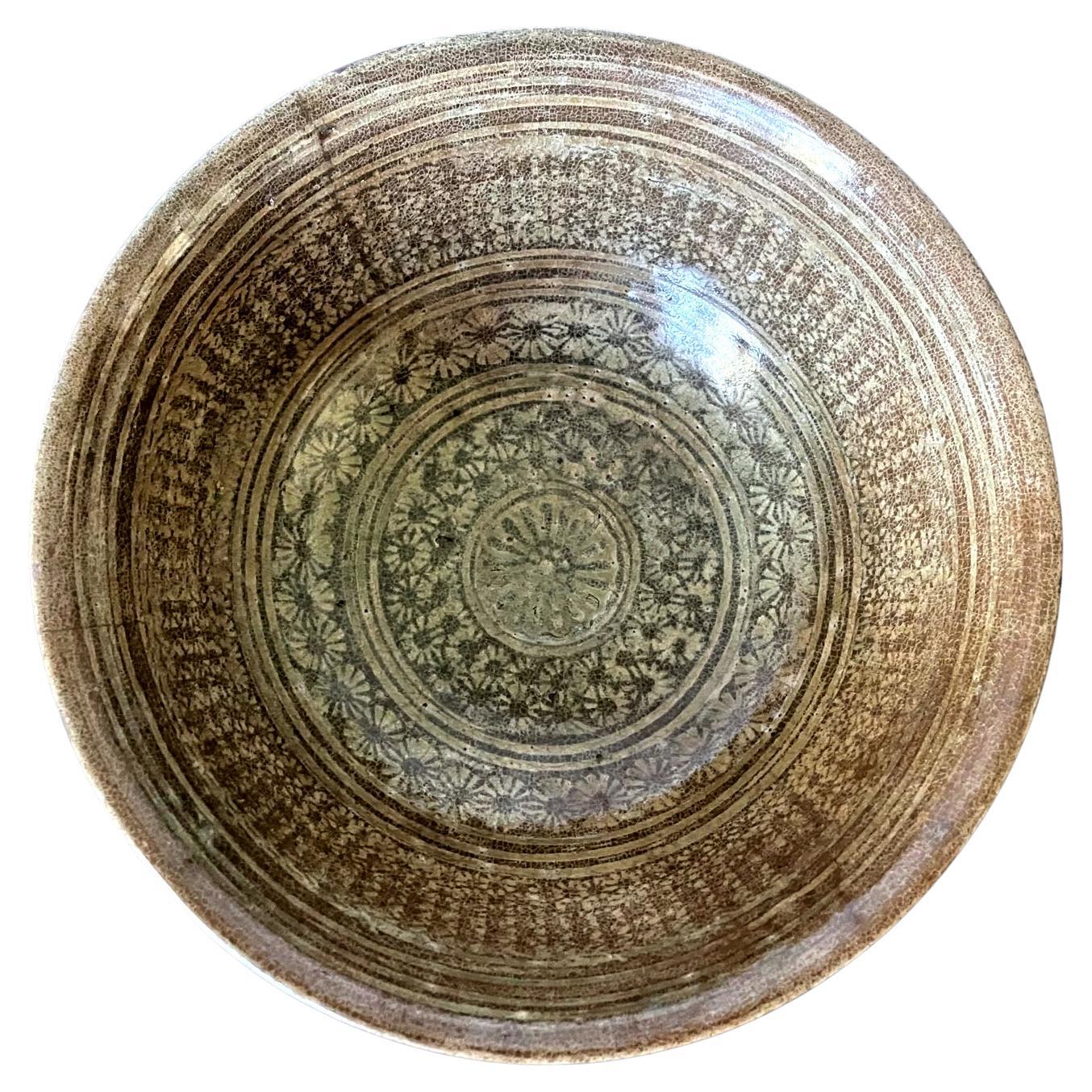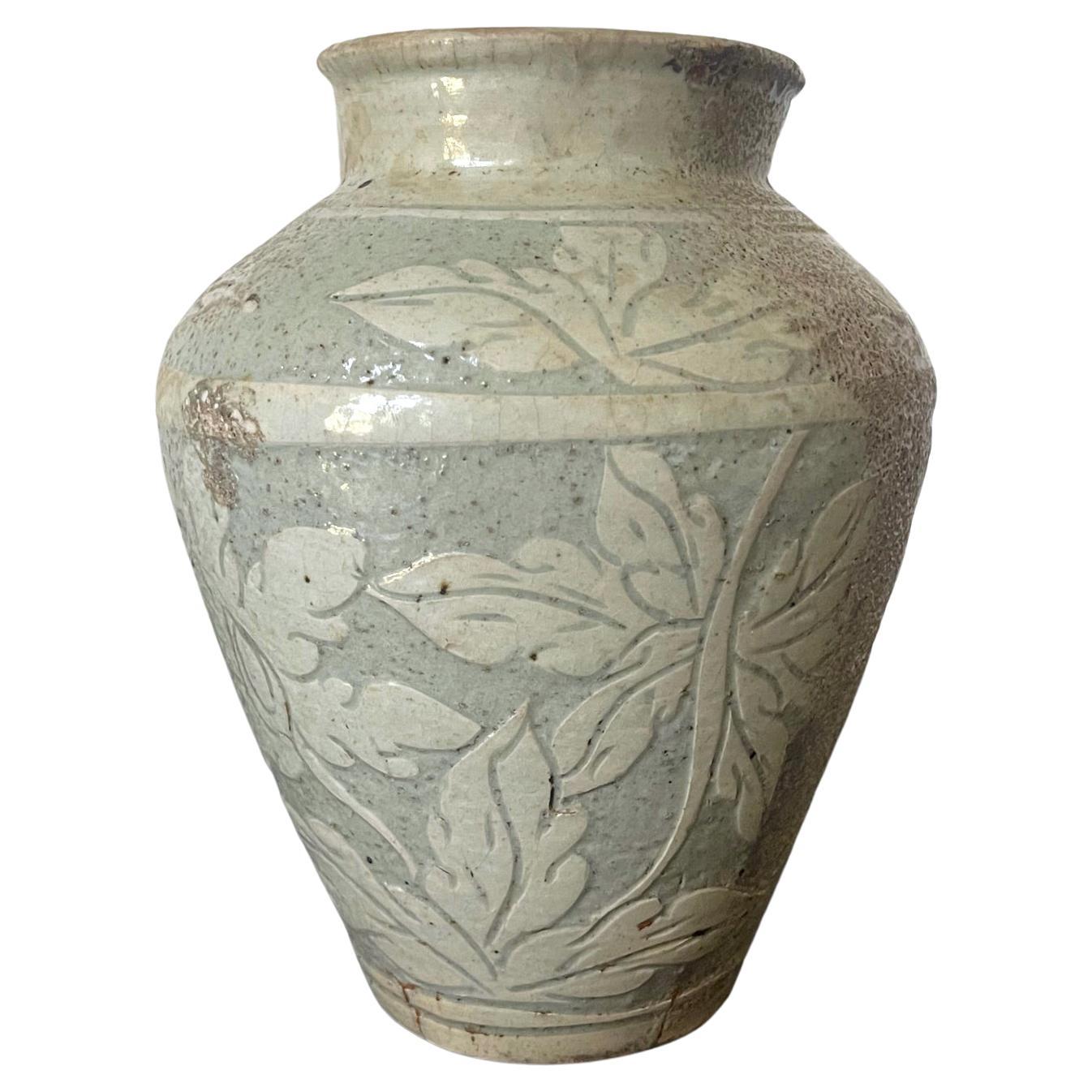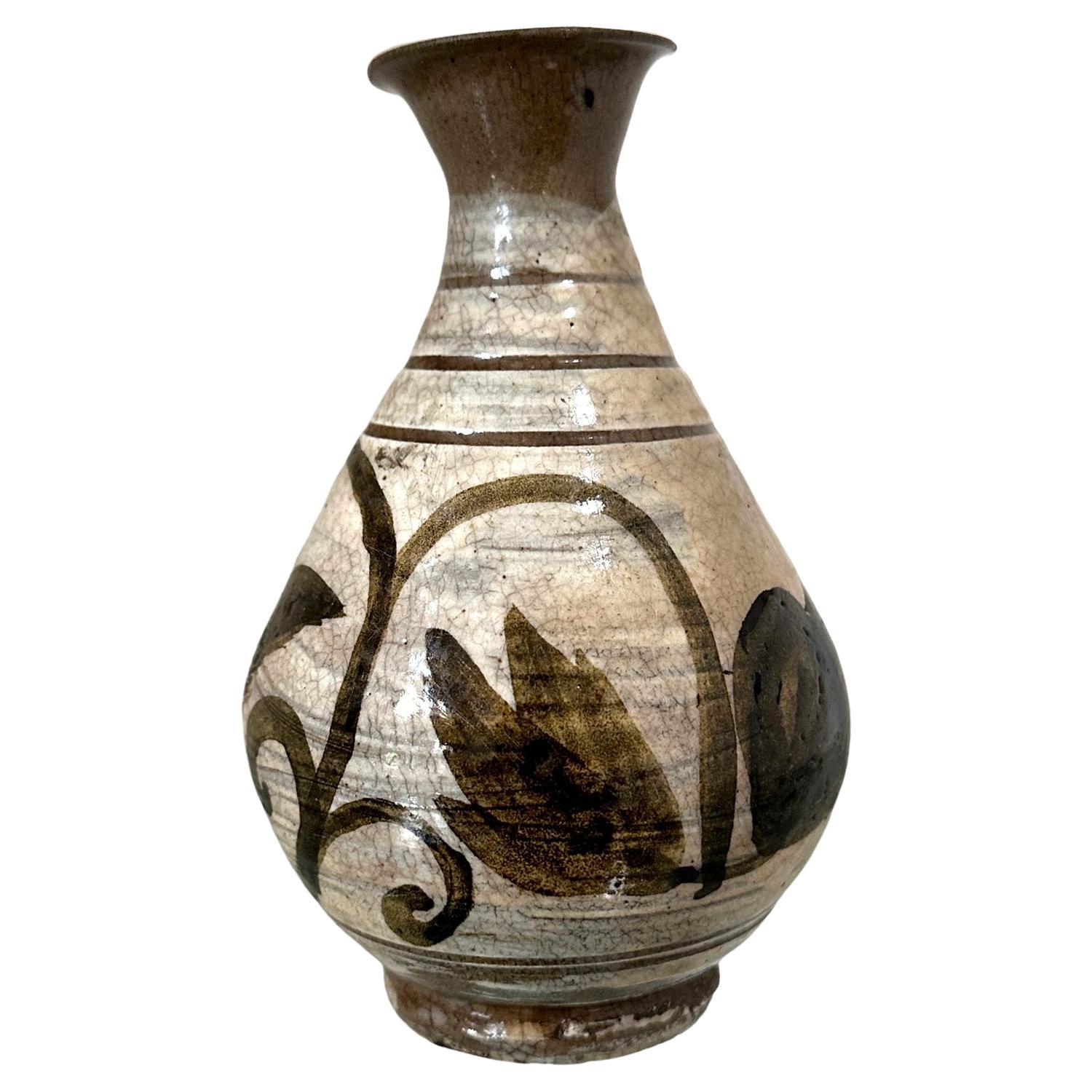Items Similar to Korean Contemporary Buncheong Ceramic Sculpture by Sung Jae Choi
Want more images or videos?
Request additional images or videos from the seller
1 of 18
Korean Contemporary Buncheong Ceramic Sculpture by Sung Jae Choi
About the Item
A ceramic sculpture piece created in the tradition of Buncheong ware by contemporary Korean ceramicist Sung Jae Choi (South Korean, b. 1962). In a hollow rectangular with slight irregularity of being hand-made, the piece evokes the distant memory of the stoneware pillow found in ancient China and Korea, but perhaps more conceptually relevant, the inspiration lies with the rice-barrel shaped Buncheong jar from early Chosen dynasty. The surface is covered in a white slip onto which the artist painted with his fingers a spontaneous aqua scenery. With just a few quick strokes, one can easily see ducks floating on the pond with willows swaying and reeds rustling in the wind, perhaps also a lotus withering after the summer bloom. Rooted in strong ceramic tradition of Buncheong ware of 14-16th century, Choi revitalized the technique to reach for a modernity that is both refined and rustic, while still retaining a strong sense of poetry and humbleness. The piece is singed on the base as shown.
Reference: for a similar piece see accession no. FE.57-2008 in the collection of Victoria and Albert Museum.
About the artist: Choi received is BFA and MFA from Hongik Art University in Seoul, Korea in Ceramic Art. He is currently a professor in the Department of Traditional Art and Craft at Korea National University of Cultural Heritage. Choi works in the Buncheong Korean ceramics tradition, showing internationally throughout Korea, Japan, Italy, France, Taiwan, Ireland, and the United States. He has traveled throughout the world via teaching, workshop, and residency positions such as Visiting Professor of Jingdezhen Ceramic University (Jingdezhen, China) in 2015 and Guest Professor of Alfred University (Alfred, NY) in 2006.
Artist's statement: The expression of my Buncheong ceramics is based on that of grayish-blue powdered celadons that were made with white clay and red stoneware clay, which was manufactured in Korea in the 16th century, leading to its maximization of modern pictorial ceramics. This method is focused on applying white slips to the surface of a vessel to maximize its pictorial elements; expression is realized through the process of applying white clay slip to the surface of a vessel with rough brushes, hands or tree branches. As for the shapes, traditionally flat square vessels or round jars are favored. The form and surface aim to express the traces of impromptu passing actions conducted by an artist as well as abstraction and contemplative landscape of a comfortable mind reminiscent of the natural image.
Expression and beauty of Buncheong ceramics are considered to be naturally gained in the process of dealing with materials, and it is hoped that they will have harmonious natural aesthetic sensitivity created through earth, fire, and human beings based on masterful techniques that have been accumulated for a long time without exaggeration or obstinacy.
- Creator:Sung Jae Choi (Artist)
- Dimensions:Height: 6.75 in (17.15 cm)Width: 12.75 in (32.39 cm)Depth: 4.25 in (10.8 cm)
- Style:Modern (Of the Period)
- Materials and Techniques:
- Place of Origin:
- Period:
- Date of Manufacture:2000s
- Condition:Wear consistent with age and use. Fine with intended surface. With inscribed wood storage box.
- Seller Location:Atlanta, GA
- Reference Number:1stDibs: LU945025550662
About the Seller
5.0
Platinum Seller
These expertly vetted sellers are 1stDibs' most experienced sellers and are rated highest by our customers.
Established in 2006
1stDibs seller since 2010
478 sales on 1stDibs
Typical response time: <1 hour
- ShippingRetrieving quote...Ships From: Atlanta, GA
- Return PolicyA return for this item may be initiated within 2 days of delivery.
More From This SellerView All
- Antique Korean Ceramic Buncheong Bowl Joseon DynastyLocated in Atlanta, GAA Korean ceramic shallow bowl on ring foot in the classic Buncheong (or Punch'ong) style from early Joseon Dynasty circa 15th century. The bowl features...Category
Antique 15th Century and Earlier Korean Archaistic Ceramics
MaterialsCeramic
- Antique Korean Ceramic Buncheong Bowl Joseon DynastyLocated in Atlanta, GAA Korean ceramic bowl supported on a short ring foot in the classic Buncheong (or Punch'ong) style from early Joseon Dynasty circa 15th century. The bow...Category
Antique 15th Century and Earlier Korean Archaistic Ceramics
MaterialsCeramic
- Antique Korean Buncheong Ceramic Vase with Incised DesignsLocated in Atlanta, GAA Korean ceramic bottle form jar of Buncheong ware circa 15-16th century Joseon Dynasty. The surface of the jar features a celadon glaze and an elaborate incised design of large flor...Category
Antique 16th Century Korean Archaistic Ceramics
MaterialsCeramic
- Korean Glazed Ceramic Vase Buncheong Ware Joseon DynastyLocated in Atlanta, GAA small antique Korean Buncheong stoneware vase from early Joseon Dynasty circa 16th century. The vase is of a classic pear form with a waisted neck, a flared mouth and a ringed base...Category
Antique 16th Century Korean Other Ceramics
MaterialsCeramic
- Korean Glazed Ceramic Vase Buncheong Ware Early Joseon DynastyLocated in Atlanta, GAAn antique Korean Buncheong stoneware vase from early Joseon Dynasty circa late 15th to early 16th century. The vase is of a classic pear form with a ...Category
Antique 15th Century and Earlier Korean Archaistic Ceramics
MaterialsCeramic
- Korean Ceramic Buncheong Ware Tea Bowl Early Joseon DynastyLocated in Atlanta, GAAn antique Korean Buncheong stoneware tea bowl (chawan) from early Joseon Dynasty circa late 15th to early 16th century. The bowl with a short ring base is nearly entirely covered in a white slip except the base (known as sougusuri in Japanese, total glaze). Iron-colored scrolling vines were painted on with quick and deft brush strokes, rendering the bowl a vital and spontaneous appeal. It appears that the bowl was dipped in the white slip instead of being brushed on, observing from the slip pattern left on the rim of the bowl. The bowl shows significant age and evident of use for tea drinking. There are losses of glaze flakes throughout, along the rim and inside the bowl. The flake off the glaze left a dark spot on the rim, exposing the deep colored clay underneath. Inside the bowl, many of the glaze flakes appear more superficial and retains a yellowing color from the tea stains (known as amamori, rain leak). There is a historical crack line on the exterior (surface only) that result in associated small losses of glaze. It appears that the crack line was the result from the kiln firing and gradually the glaze around it started to reduce. The bowl comes with a later wrapping cloth and a wood tomobako box, but they are not original to the piece. This particular type of Buncheong ware was associated with the Hakbong-ri kilns in the sacred Mount Gyeryong Mountains, west of Daejeon city in the Chungcheong province. During early Joseon Dynasty, the emperor decided to reject Buddhism to embrace the Confucianism. As a result, many monks were forced to abandon their religious life and returned to the secular society. The monks in Gyeryong mountains set up the kilns and started to produce this so called "Hakbong-ri" type of Buncheong ware. The production was shorted-lived for only a few decades from late 15th to early 16th century before it turned to porcelain, but the ware made during that period was noted for their fresh and enigmatic appeal with deft iron-paint decoration. Collectors cherish these rare pieces for their vitality and spontaneity often used them on important occasions of chado in Japan and passed down to generation. For a similar bowl, see Catalog 52 illustrated on page 87 of the book "Korean Buncheong Ceramics...Category
Antique 15th Century and Earlier Korean Archaistic Ceramics
MaterialsCeramic
You May Also Like
- Yeo Byong-Uk Korean Multi-Fired Stoneware Pottery Ceramic Vessel Vase SculptureLocated in Studio City, CABreathtaking in execution and form. Minimalist in design yet commanding the viewer's attention. This amazing piece is by Korean contemporary ceramist Yeo Byong-uk who is predominantl...Category
21st Century and Contemporary Korean Modern Sculptures and Carvings
MaterialsStoneware
- Korean Buncheong Joseon Dynasty Glazed Pottery Ceramic Calligraphy VaseLocated in Studio City, CAA beautifully glazed and colored, hand-decorated Korean Buncheong vase. Joseon Dynasty (1392-1910). Very nice patina. We are listing it as 19th cent...Category
Antique 19th Century Korean Ceramics
MaterialsEarthenware
- Vintage Traditional Japanese Young Woman Ceramic SculptureLocated in North Hollywood, CAJapanese lady sculpture wood fired handmade ceramic pottery. Traditional Japanese young woman small sculpture. Unusual shape beautiful collectib...Category
Late 20th Century Japanese Japonisme Sculptures and Carvings
MaterialsCeramic
- Korean Buncheong Joseon Dynasty Antique Glazed Pottery Ceramic Wabi-Sabi VaseLocated in Studio City, CAA beautifully and sumptuously blue and white crackle glazed and colored, moon pot shaped, hand-decorated/painted Korean Buncheong porcelain vase. Joseon Dynasty (1392-1910). The vase...Category
Antique 19th Century Korean Ceramics
MaterialsPorcelain, Pottery
- Pair of Life-Size Italian Black and White Great Dane Dog Ceramic SculpturesLocated in New York, NYA majestic pair of Mid-Century Modern Italian life-size black and white ceramic Great Dane dogs depicted in two different seated stances on black ba...Category
Mid-20th Century Italian Mid-Century Modern Sculptures and Carvings
MaterialsCeramic
- Antique Islamic Turkish Ottoman Ceramic TileLocated in North Hollywood, CAAntique 19th century hand painted Islamic Turkish ottoman ceramic tile. Painting figure of a Shah Suleiman in a palace before a colonnade and curtain. Arabic script on left top corne...Category
Vintage 1920s Turkish Moorish Ceramics
MaterialsCeramic
Recently Viewed
View AllMore Ways To Browse
Modern Korean Furniture
Korean Modern
Asian Artist Contemporary Furniture
Ceramics Red Clay
Modern Asian Ceramics
Asian Rice
Korean Japanese
Chinese Covered Jar
Korea Ceramics
Pillows French Contemporary
Japanese Blue And White Ceramic
Aqua Ceramics
Hollow Ceramic
Ancient Chinese Ceramics
Grayish Blue
Taiwanese Ceramic
Asian Tree Sculpture
Chinese White Ceramic Jar





